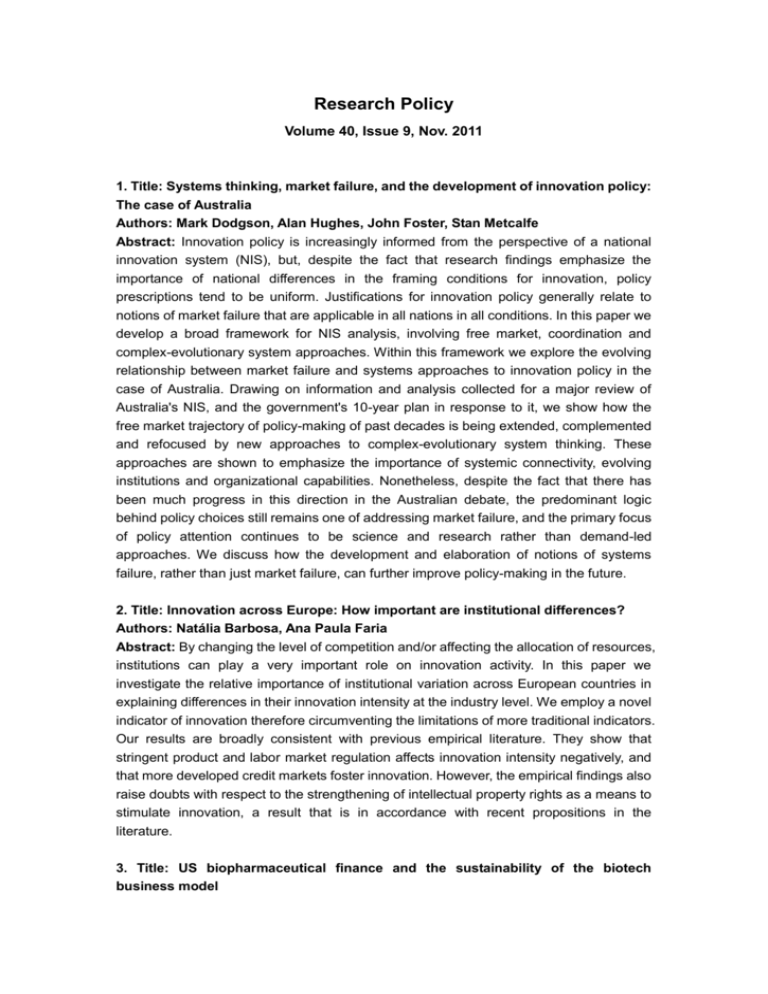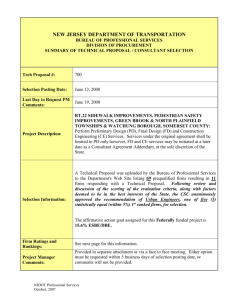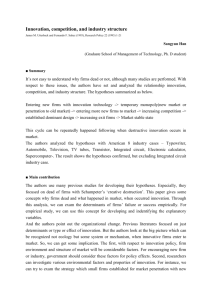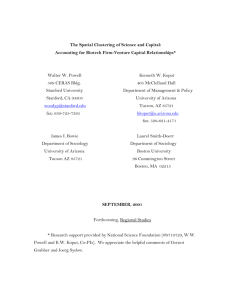Research Policy Volume 40, Issue 9, Nov. 2011 1. Title: Systems
advertisement

Research Policy Volume 40, Issue 9, Nov. 2011 1. Title: Systems thinking, market failure, and the development of innovation policy: The case of Australia Authors: Mark Dodgson, Alan Hughes, John Foster, Stan Metcalfe Abstract: Innovation policy is increasingly informed from the perspective of a national innovation system (NIS), but, despite the fact that research findings emphasize the importance of national differences in the framing conditions for innovation, policy prescriptions tend to be uniform. Justifications for innovation policy generally relate to notions of market failure that are applicable in all nations in all conditions. In this paper we develop a broad framework for NIS analysis, involving free market, coordination and complex-evolutionary system approaches. Within this framework we explore the evolving relationship between market failure and systems approaches to innovation policy in the case of Australia. Drawing on information and analysis collected for a major review of Australia's NIS, and the government's 10-year plan in response to it, we show how the free market trajectory of policy-making of past decades is being extended, complemented and refocused by new approaches to complex-evolutionary system thinking. These approaches are shown to emphasize the importance of systemic connectivity, evolving institutions and organizational capabilities. Nonetheless, despite the fact that there has been much progress in this direction in the Australian debate, the predominant logic behind policy choices still remains one of addressing market failure, and the primary focus of policy attention continues to be science and research rather than demand-led approaches. We discuss how the development and elaboration of notions of systems failure, rather than just market failure, can further improve policy-making in the future. 2. Title: Innovation across Europe: How important are institutional differences? Authors: Natália Barbosa, Ana Paula Faria Abstract: By changing the level of competition and/or affecting the allocation of resources, institutions can play a very important role on innovation activity. In this paper we investigate the relative importance of institutional variation across European countries in explaining differences in their innovation intensity at the industry level. We employ a novel indicator of innovation therefore circumventing the limitations of more traditional indicators. Our results are broadly consistent with previous empirical literature. They show that stringent product and labor market regulation affects innovation intensity negatively, and that more developed credit markets foster innovation. However, the empirical findings also raise doubts with respect to the strengthening of intellectual property rights as a means to stimulate innovation, a result that is in accordance with recent propositions in the literature. 3. Title: US biopharmaceutical finance and the sustainability of the biotech business model Authors: William Lazonick, Öner Tulum Abstract: In the decade before the 2008 economic crisis, the US biotechnology industry was booming. In a 2006 book, Science Business: The Promise, the Reality, and the Future of Biotech, Gary Pisano implies that, given the 10–20 year time-frame for developing biotech products and the lack of profitability of the industry as a whole, the US biotech boom should not have happened. Yet the biotech industry has received substantial funding from venture-capital firms as well as from established companies through R&D alliances. Why would money from venture capitalists and big pharma flow into an industry in which profits are so hard to come by? The purpose of this article is to work toward a solution of what might be called the “Pisano puzzle”, and in the process to provide a basis for analyzing the industrial and institutional conditions under which the growth of the US biopharmaceutical (BP) industry is sustainable. One part of the answer has been the willingness of stock-market investors to absorb the initial public offerings (IPOs) of a BP venture that has not yet generated a commercial product, and indeed may never do so. The other part of the answer is that the knowledge base that BP companies can tap to develop products comes much more from government investments and spending than from business finance. Indeed, we show that, through stock buybacks and dividends, established corporations in the BP industry have been distributing substantial sums of cash to shareholders that may be at the expense of R&D. We use the framework that we have developed for analyzing the sustainability of the US BP business model to pose a number of key areas for future research and policy, with an emphasis on the implications of the financialization of this business model for the generation of safe and affordable BP drugs as well as the need for a theory of innovative enterprise. 4. Title: Spatial collocation and venture capital in the US biotechnology industry Authors: Christos Kolympiris, Nicholas Kalaitzandonakes, Douglas Miller Abstract: Biotechnology firms operate in a high-risk and high-reward environment and are in a constant race to secure venture capital (VC) funds. Previous contributions to the literature show that the VC firms tend to invest locally in order to monitor their investments and to provide operating assistance to their target firms. Further, biotechnology is a knowledge-based industry that tends to exhibit spatial clusters, and the firms in such industries may collocate to benefit from gaining access to local markets for specialized inputs (e.g., skilled researchers) and from local knowledge spillovers and network externalities. If such gains exist, we expect that the collocated firms should exhibit positively correlated performance, including in their ability to attract venture capital funds. The purpose of this paper is to empirically measure the strength and spatial extent of the relationships among the amount of funds raised by proximate biotechnology firms. We model these relationships with a spatial autoregression (SAR) model, and we control for characteristics of the biotechnology firms and the VC firms that provide their funds as well as site-specific factors. Based on our fitted SAR model, we find that the amount of venture capital raised by a particular biotechnology firm is significantly influenced by the number of VC firms and the VC funding levels raised by biotechnology firms located within a 10-mile radius, but these relationships are not statistically significant beyond this range. 5. Title: Incorporating technical risk in compound real option models to value a pharmaceutical R&D licensing opportunity Authors: D. Cassimon, M. De Backer, P.J. Engelen, M. Van Wouwe, V. Yordanov Abstract: The valuation of multi-staged pharmaceutical R&D can be interpreted as a chain of real options. In valuing these compound option models, a crucial problem is how to deal with the different types of risk. Previous models, such as Cassimon et al. (2004), offer a closed-form solution for the valuation of a new drug development using a generalized n-fold compound option model, but implicitly bundle both commercial and technical risk in one risk measure. We extend this model by explicitly incorporating technical risk, while still preserving the closed-form solution of the model. As such, this extended model is better suited to handle real-life valuation cases in the pharmaceutical industry. We document the theoretical model with a real-life project of a major pharmaceutical multinational. 6. Title: To explore or to exploit? An empirical investigation of acquisitions by large incumbents Authors: Marcus Wagner Abstract: Innovation in high technology industries poses considerable challenges, frequently forcing firms to consider using acquisitions as a means of sourcing technology. This paper investigates such behaviour in a major high technology sector, namely the semiconductor industry. The paper focuses on differential effects of technology-related versus nontechnological acquisitions on exploratory and exploitative research and innovation. Most importantly, it confirms the important role of technology-related acquisitions for exploratory innovation. 7. Title: Inside multi-disciplinary science and engineering research centers: The impact of organizational climate on invention disclosures and patents Authors: Emily M. Hunter, Sara Jansen Perry, Steven C. Currall Abstract: Much past research on commercialization activities by university scientists and engineers has focused on the role of resources in the extra-organizational commercialization environment, such as the availability of venture capital funding. By contrast, our theoretical and empirical interest was in intra-organizational dynamics impacting the context in which scientists and engineers work. Drawing upon organizational psychology literature on the construct of organizational climate, we posited that researchers working in an intra-organizational climate that supports commercialization and encourages intra-organizational boundary-spanning will be more likely to produce invention disclosures and patents. Our data from 218 respondents at 21 engineering research centers was both multi-method (i.e., qualitative data from interviews, longitudinal archival data, and survey data) and multi-level. Our results showed that an organizational climate characterized by support for commercialization predicted invention disclosures one year later and an organizational climate characterized by boundary-spanning predicted patent awards two years later. 8. Title: Linking induced technological change, and environmental regulation: Evidence from patenting in the U.S. auto industry Authors: Jaegul Lee, Francisco M. Veloso, David A. Hounshell Abstract: This article uses a carefully screened patent database in automobile emission control technologies and a detailed regulatory action analysis to examine firms’ innovation in response to U.S. technology-forcing auto emissions standards enacted between 1970 and 1998. The study finds that under the performance-based technology-forcing (PBTF) auto emissions regulations, both automakers and component suppliers innovated and introduced more advanced emission control technologies for automobile applications. The study also shows that stringent PBTF regulation temporarily induced domestic U.S. firms to become more innovative than foreign firms that operated in the local U.S. market during the early phase of the regulatory regime. Findings of this research strongly imply that government intervention in the form of technology-forcing regulation can drive firms to invest in technological innovation. 9. Title: Environmental policy vs. public pressure: Innovation and diffusion of alternative bleaching technologies in the pulp industry Authors: David Popp, Tamara Hafner, Nick Johnstone Abstract: In the late 1980s and early 1990s, concern over dioxin in both paper products and wastewater led to the development of techniques that reduced the use of chlorine in the pulp industry. Both regulatory and consumer pressure motivated this change. Unlike previous studies, we use patent data to examine the evolution of two competing bleaching technologies in five major paper-producing countries, both of which reduce the use of chlorine in the pulping process. The use of patent data allows us to focus on the invention stage. However, adoption data are also presented, and by the end of the 1990s, nearly all pulp production in these countries used one of these technologies. While previous studies emphasize the importance of regulation for inducing innovation, here we find substantial innovation occurring before regulations were in place. Instead, pressure from consumers and the public at large to reduce the chlorine content of paper drove invention, prior to the introduction of environmental policies in any of the countries concerned. 10. Title: The impact of funding on research collaboration: Evidence from a developing country Authors: Diego Ubfal, Alessandro Maffioli Abstract: In this paper we evaluate the impact of research grants on the amount of collaboration among scientific researchers in Argentina. We find a positive and significant impact of funding on collaboration which is measured in terms of the number of co-authors for publications in peer-reviewed journals. Our identification strategy is based on comparing collaboration indicators for researchers with financially supported projects with those of a control group of researchers who submitted projects that were accepted in terms of quality, but not supported because of shortage of funds. We obtain consistent results by using different non-experimental techniques including difference-in-differences models combined with propensity score matching algorithms. 11. Title: Self-organization of industrial clustering in a transition economy: A proposed framework and case study evidence from China Authors: Zheng He, Lez Rayman-Bacchus, Yiming Wu Abstract: The evolution of the industrial cluster has long been a comparatively difficult problem due to its complexity and the differing particularities of individual clusters. Based on a study of two clusters, this paper draws some logic and ideas from complexity theory and develops a generic framework to explain cluster self-organization. We present the cluster as a complex adaptive system (CAS) that experiences self-organization through four critical features: landscape design, positive feedback, boundary constraints, and novel outcomes. We then use this framework to analyze two clusters from the ICT sector within China's transitional economy. Finally, the paper draws out a few implications for our understanding of cluster development processes. In particular, we stress the importance of both path-dependence (due to initial conditions) and the unpredictability of developmental paths (due to the uniqueness of each cluster). 12. Title: A functionalist framework to compare research systems applied to an analysis of the transformation of the Chinese research system Authors: Koen Jonkers Abstract: This paper presents an analytical framework for the comparative analysis of National Research Systems. We follow evolutionary accounts of the research system in combination with insights from functionalist economics of innovation and organisational theorists. We also illustrate the potential use of this framework by applying it to an analysis of the Chinese research system's transformation between 1980 and 2005. During this period, this system is considered to have gradually changed from a centrally planned system to a mixed model. This implies a move in the direction of a ‘perfect market ideal type’. The increased performance of the overarching functions of the research system can be partially explained by these institutional changes.









